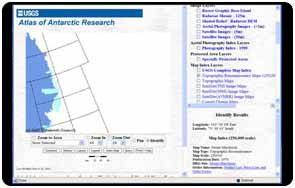Project: |
Atlas of Antarctic Research FY2004 |
||
| Leaders: |
Cheryl A. Hallam, challam@usgs.gov |
||
| Overview: | Background The Atlas of Antarctic Research first became available in 1999. Version 2 of the Atlas was installed on the server in February 2003, providing increased display and search capabilities and access to more maps and information by the research community. It provides a specialized “Zoom to Area” function so that users can go directly to a selected site. The scale is now more accurate as the fraction has been replaced with a bar scale that uses kilometers as its units of display. What was previously only a search of the Antarctic Geographic Names database is now a double search capability. The query button allows the user to search for maps produced by USGS and the results can be displayed on the map in part or in full. Detailed (sub-meter horizontal resolution) orthophotos of six islands off the coast of Palmer station are now available for viewing in the Atlas. The image to the right is a portion of Torgersen Island and the resolution of the image permits the viewer to count penguins. It, and similar images, was generated by USGS for an NSF-funded science project at Montana State University. Through these images, the Atlas provides detailed views of two of the Antarctic Specially Protected Areas in the Palmer Station vicinity – Biscoe Point and Litchfield Island. Locations of all ASPA’s are now available for scientists to check when proposing research to prevent proposals from requesting access to those areas. The point files are from the SCAR files and provide only very generalized coordinates for the sites. Several of the sites provide access to page size maps of the areas through the identify function. Selected 30-meter and 5-meter satellite images generated through the satellite image-mapping project are also available for viewing in the Atlas. These include the images used to generate the 1:250,000-scale satellite image maps and those used for the 1:50,000 and 1:25,000-scale maps. Through a cooperative project with the University of New Hampshire, a prototype geodatabase will be built for selected portions of the Atlas database and formal metadata produced for the satellite images and the maps generated from them. The Atlas also offers access to digital elevation models (DEM) and shaded relief views of portions of the McMurdo Dry Valleys and Vicinity that were generated from the lidar Airborne Terrain Mapping project. As can be seen at the right, details of the surface of the Nussbaum Reigel become easily visible using the lidar data, and the areas with no coverage can also be seen. On its entry page, the Atlas provides an index layer to show extent, and downloads of both the DEM's and shaded relief images of the data. Surface details of a portion of Taylor Valley can be seen in the shaded relief generated from the 2-meter digital elevation model in the figure to the right. The snout of Taylor Glacier and most of Lake Bonney can be seen, as well as details of the valley walls above the lake. Other glaciers can also be seen on both sides of the valley. More details of a small portion of the image to the right can be seen in the photograph below. The Atlas also provides access to the digital raster graphics created the from USGS-generated 1:250,000-scale. Access is provided through the Map Index Layers: Topographic Resonnaissance Maps (1:250,000). The identify button is used to display the active link to the DRG page. The DRG is displayed in a separate window with zoom capabilities and a button to download the map. The downloadable file is a zip file containing the tiff, tfw, and metadata files which describe the map. The map is provided in a full georeferenced form and can be used as a base for the display and/or collection of other data relevant to the area covered. Version 2 of the Atlas supports the display of Antarctic Named Geographic Features as a single layer or by feature type. Photo centers of the 1999 aerial photography project are available with flight line and frame number displayed through the identify function. A sample set of fault lines was also geo-referenced and added to the Research Layers along with the 2000 Landing Sites for helicopters, Twin Otters, and LC-130’s. |

Details of the surface of the Nussbaum Reigel become easily visible using the lidar data, and the areas with no coverage can also be seen. 
Surface details of a portion of Taylor Valley can be seen in the shaded relief generated from the 2-meter digital elevation model in this figure. 
DRG Screen shot. 
Screen shot of Version 2 of the Atlas of Antarctica Research web site.
|
|
| USGS Mission Tie In: |
|
||
| Discipline: | Water | ||
| Locations: | Antarctica | ||
| Web Sites: | |||
|
|
|||
|
|
|
|
|
|
| U.S.
Department of the Interior | U.S.
Geological Survey URL: http://international.usgs.gov /projects/aa-atlas.htm Maintain: International Programs Web Team Last Update: August 4, 2004 Send Comments| Privacy | Disclaimer | Accessibility |